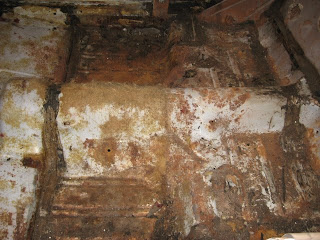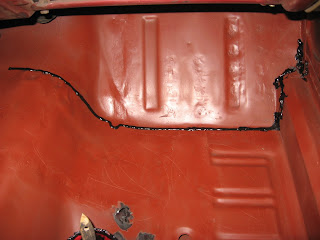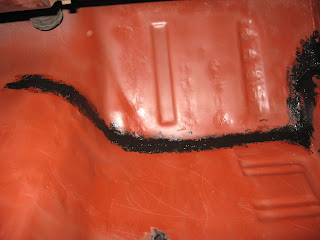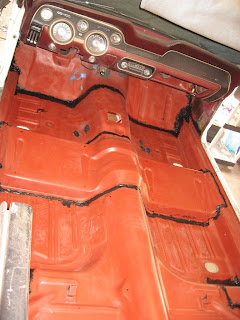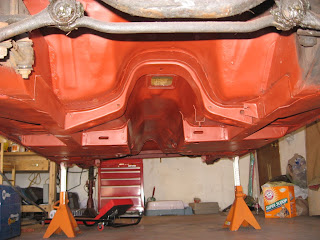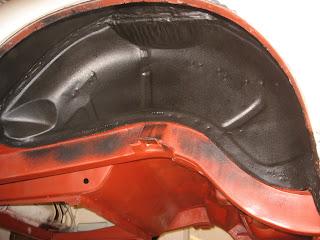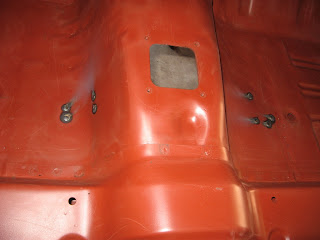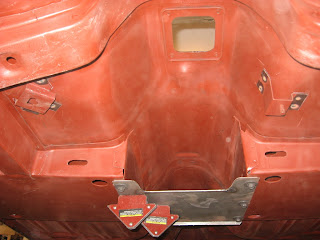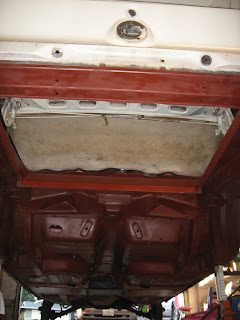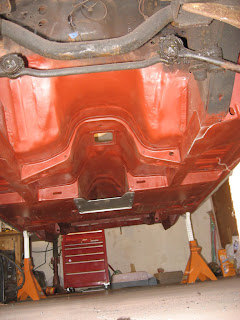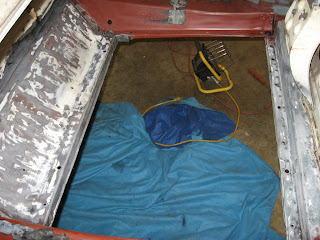 ... the coil spring is connected to the spring perch. The spring perch is connected to the upper control arm. The upper control arm is connected to the upper ball joint. The upper ball joint is connected to the spindle. The spindle is connected to the lower ball joint. And, the lower ball joint is connected to the lower control arm. The upper control arm and lower control arm are both connected to the shock tower and that's what it's all about.
... the coil spring is connected to the spring perch. The spring perch is connected to the upper control arm. The upper control arm is connected to the upper ball joint. The upper ball joint is connected to the spindle. The spindle is connected to the lower ball joint. And, the lower ball joint is connected to the lower control arm. The upper control arm and lower control arm are both connected to the shock tower and that's what it's all about.
 So, now that I'm up on my suspension anatomy, it's time to tear it down starting with the front shock absorber which is bolted to the shock tower cap which is bolted to the shock tower via 3 nuts. Two nuts under the spring perch holds the bottom of the shock so these are removed as well to remove the shock from within the spring.
So, now that I'm up on my suspension anatomy, it's time to tear it down starting with the front shock absorber which is bolted to the shock tower cap which is bolted to the shock tower via 3 nuts. Two nuts under the spring perch holds the bottom of the shock so these are removed as well to remove the shock from within the spring.
 The coil spring needs to be compressed to allow the removal of the shock perch from the upper control arm. Compressing coil springs is serious business. A sudden decompression can do you serious harm so I lost a little sleep over what to do about this. I searched the VMF and the web in general and found some people that had good luck with internal claw-type spring compressors and generally agree that external compressors are bad news for this application. However, some guys still mentioned that the claws on the internal style slip if you're not careful and recommend clamping the claws to the spring as a precaution. Other folks mentioned using something called a bolt-in spring compressor like Ford service centers supposedly originally used. They recommended a site called Daze Cars so I took a look. I was sold by the claim that a bolt-in compressor is safer than the other styles so I printed out the instructions from the Daze site on how to construct one and bought my parts at the local True Value hardware. Total cost was around $30 for more than twice as much material as I needed.
I measured, cut, and welded until I had something that looked reasonably like it was supposed to:
The coil spring needs to be compressed to allow the removal of the shock perch from the upper control arm. Compressing coil springs is serious business. A sudden decompression can do you serious harm so I lost a little sleep over what to do about this. I searched the VMF and the web in general and found some people that had good luck with internal claw-type spring compressors and generally agree that external compressors are bad news for this application. However, some guys still mentioned that the claws on the internal style slip if you're not careful and recommend clamping the claws to the spring as a precaution. Other folks mentioned using something called a bolt-in spring compressor like Ford service centers supposedly originally used. They recommended a site called Daze Cars so I took a look. I was sold by the claim that a bolt-in compressor is safer than the other styles so I printed out the instructions from the Daze site on how to construct one and bought my parts at the local True Value hardware. Total cost was around $30 for more than twice as much material as I needed.
I measured, cut, and welded until I had something that looked reasonably like it was supposed to:
 Now, there were general instructions around the net about how to use one of these compressors but I couldn't find actual step-by-step instructions on how to install it so consider this my gift to whomever else wants a to see one in action, so here it is.
Basically, the compressor installs in place of the shock.
Now, there were general instructions around the net about how to use one of these compressors but I couldn't find actual step-by-step instructions on how to install it so consider this my gift to whomever else wants a to see one in action, so here it is.
Basically, the compressor installs in place of the shock.  The bottom of the compressor bolts to the spring perch where the lower shock absorber mounts were bolted.
The bottom of the compressor bolts to the spring perch where the lower shock absorber mounts were bolted.
 And the top of the compressor is bolted to the top of the shock tower cap where the top of the shock absorber was mounted. The threaded rod portion of the compressor is separate from the plate that's bolted to the shock tower cap and the rod extends up through the plate. A large nut is torqued down against the plate which compresses the spring upwards.
And the top of the compressor is bolted to the top of the shock tower cap where the top of the shock absorber was mounted. The threaded rod portion of the compressor is separate from the plate that's bolted to the shock tower cap and the rod extends up through the plate. A large nut is torqued down against the plate which compresses the spring upwards.
 Here's the spring after being compressed about 50% of the required amount.
Here's the spring after being compressed about 50% of the required amount.
 The task at hand is to remove the shock perch from the upper control arm and then to remove the upper control arm so that the spring can be uncompressed and removed. Here I've separated the upper ball joint from the spindle using a pickle fork (I had a fairly difficult time finding one to purchase, btw).
The task at hand is to remove the shock perch from the upper control arm and then to remove the upper control arm so that the spring can be uncompressed and removed. Here I've separated the upper ball joint from the spindle using a pickle fork (I had a fairly difficult time finding one to purchase, btw).
 These two large nuts as seen from the engine compartment are what's holding the upper control arm to the shock tower. Remove those, and the upper control arm drops away.
These two large nuts as seen from the engine compartment are what's holding the upper control arm to the shock tower. Remove those, and the upper control arm drops away.
 After the upper control arm is removed, the spring can be decompressed. The shock tower cap can be removed, and the spring and compressor can be removed.
After the upper control arm is removed, the spring can be decompressed. The shock tower cap can be removed, and the spring and compressor can be removed.
 Here's the spring after being removed. Note that the spring perch came out with the spring. I then removed the two nuts from the spring perch and removed the compressor.
Here's the spring after being removed. Note that the spring perch came out with the spring. I then removed the two nuts from the spring perch and removed the compressor.
 Before removing the lower control arm, however, the spindle had to be removed first. The outer steering tie rod had to be separated from the spindle as did the lower control arm ball joint. Then the sway bar link had to be removed from the lower control arm followed by the two big nuts of the passenger side strut rod. Finally, one long bolt could then be removed allowing the separation of the lower control arm.
Before removing the lower control arm, however, the spindle had to be removed first. The outer steering tie rod had to be separated from the spindle as did the lower control arm ball joint. Then the sway bar link had to be removed from the lower control arm followed by the two big nuts of the passenger side strut rod. Finally, one long bolt could then be removed allowing the separation of the lower control arm.
 Nothing left but a empty shock tower.
Nothing left but a empty shock tower. The driver side was done next in the same manner. I then removed the steering assembly by removing three bolts from the steering box on the drivers side and two bolts on the passenger side. The sway bar was removed by removing two bolts from the bushing mounts on both sides of the car.
The driver side was done next in the same manner. I then removed the steering assembly by removing three bolts from the steering box on the drivers side and two bolts on the passenger side. The sway bar was removed by removing two bolts from the bushing mounts on both sides of the car.
The strut rods, on the other hand, were and adventure. To get them off, you need to remove a smaller 7/8" nut and then a larger 1" nut. The problem is that you need to remove that larger nut over miles and miles of rusty thread. 
Also, to remove that 1" nut requires a lot of torque so it's best removed while still attached to the lower control arm... which I had removed. So, I had to temporarily reinstall the lower control arm, insert the two strut rod studs and replace their nuts before I could start wrenching on that unholy monstrosity. I had to go so far as to purchase a 1" combination wrench just for this task. I also bought some deep 1/2" impact sockets but the 1" socket wasn't deep enough to reach the nut. It worked to hook a jack handle tube over the open end of the combination wrench to use as a cheater bar to break the bolts. Then a lot of wrenching and WD40 to get it past the threads. The strut rods slide out of the big rubber bushings toward the control arms thus completing the removal of the suspension.

